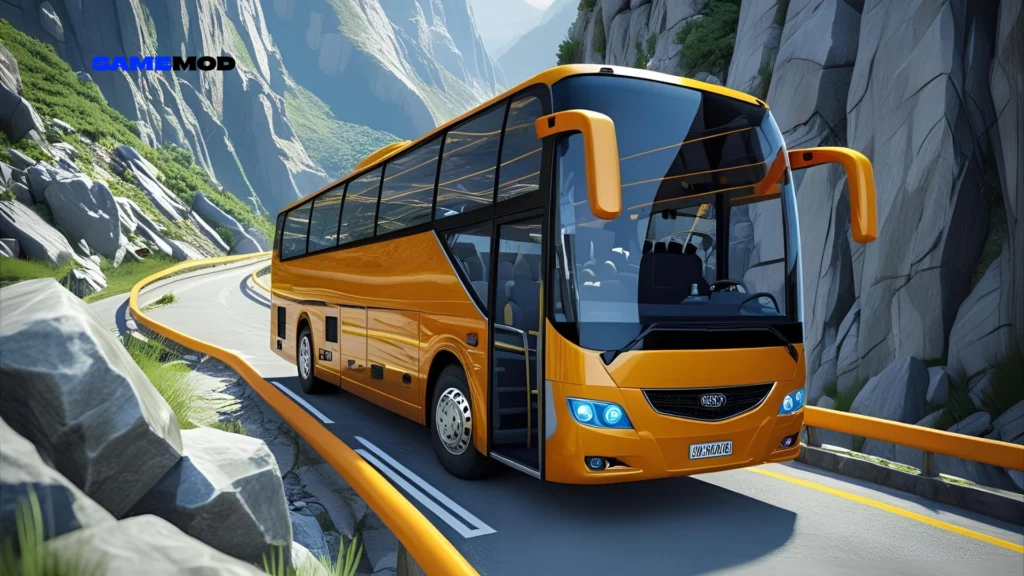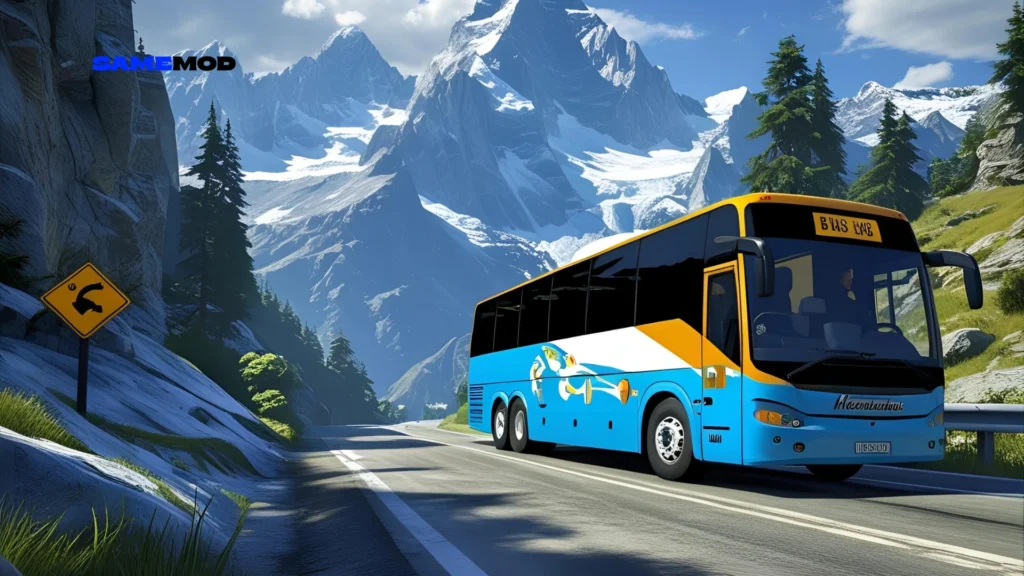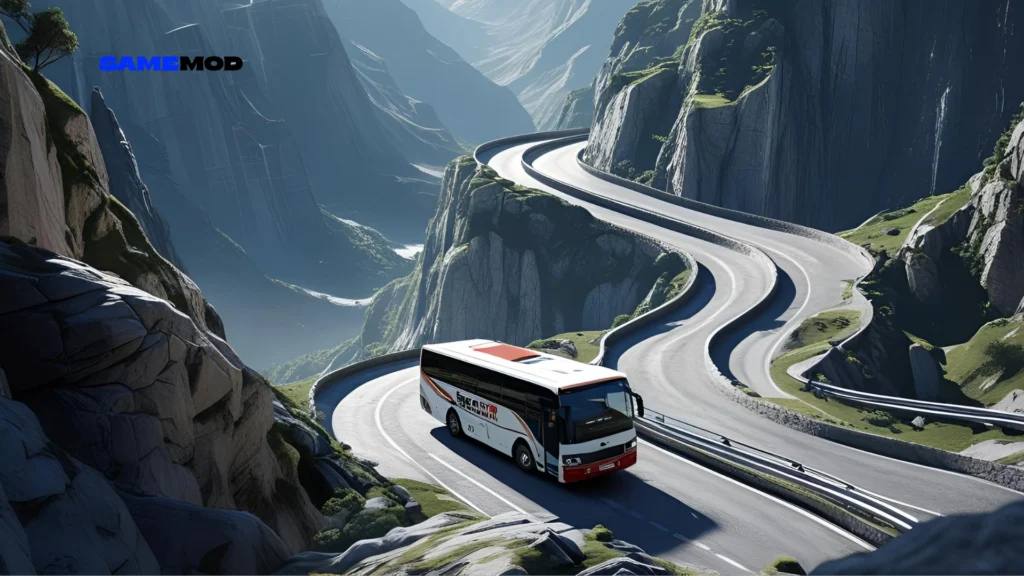Mountain Bus Driver

Players must safely carry passengers while navigating perilous alpine paths in Mountain Bus Driver. Additionally, this simulation game blends breathtaking alpine scenery with realistic driving mechanics. Players have to become adept at navigating tight spaces, steep inclines, and erratic weather.
Fundamental Gameplay Elements
Controls for Driving
Players use simple keyboard or gamepad controls to operate a fully functional mountain bus. The game also has realistic physics that react to weather, terrain, and speed. As a result, drivers need to carefully control their steering, braking, and acceleration.
Navigation of the Route
There are several mountain passes throughout the game, each with varying degrees of difficulty. Additionally, every route has its own set of difficulties, such as elevation changes and hairpin corners. Players also have to deal with landslides, construction zones, and seasonal road closures.
Vehicle Features
| Component | Function | Impact on Gameplay |
| Engine | Powers uphill climbs | Affects speed and fuel consumption |
| Brakes | Controls descent speed | Prevents overheating on long descents |
| Transmission | Manages gear ratios | Optimizes performance on steep grades |
| Suspension | Absorbs road impacts | Improves passenger comfort ratings |
System for Passenger Management
The Boarding Procedure
With predetermined destinations in mind, passengers board at selected mountain stations. As a result, drivers must adhere to set timetables while maintaining passenger safety. Consequently, reputation ratings are lowered for late arrivals.
Comfort Scores
The game uses a variety of comfort parameters to measure passenger happiness. In particular, forceful braking lowers ratings whereas calm driving raises them. Additionally, preserving the ideal temperature and offering picturesque vistas improve the experience.
Environmental Difficulties
Weather:
- Snow and Ice: Decreases vision and traction considerably;
- Rain: Produces slick surfaces and poor visibility;
- Fog: Reduces sight distance on mountain bends;
- Wind: Impacts vehicle stability on exposed slopes
Seasonal Differences
Every season has unique difficulties that have a significant impact on gaming. Winter thus necessitates the use of snow chains and careful driving practices. Snowmelt causes road washouts and mudslides in the spring.

System of Progress
Experience Points
Passenger pleasure and successful route completions provide players experience. Bonus points are also awarded for safety records, fuel efficiency, and timeliness. As a result, reliable performance opens up more difficult routes and vehicle improvements.
Content Unlockable
New busses, routes, and personalization choices are revealed by the advancement system. Players may also buy improved brakes, comfort amenities, and updated engines. In a similar vein, paint schemes enable individual expression through cosmetic alterations.
Types of Routes
Novice Routes
These beginner routes include spacious learning lanes and mild gradients. In addition, the weather is still pleasant with little traffic. As a result, novice gamers acquire necessary abilities without facing too many difficulties.
Moderate Difficulties
Narrower mountain paths and higher gradients are introduced by mid-level routes. Players also have to deal with more passengers and mild weather conditions. Strategic planning is therefore necessary for effective completions.
Professional Journeys
Advanced routes put your skills to the test in hazardous situations and drastic elevation fluctuations. Additionally, the most beautiful yet dangerous alpine terrain may be found along these routes. Only proficient drivers thereafter have steady success ratings.
Technical Details
Engine for Graphics
To create realistic mountain settings, the game makes use of cutting-edge graphics technology. Dynamic lighting systems also provide realistic dawn and sunset effects. Furthermore, particle effects provide realistic simulations of dust, rain, and snow clouds.
Sound Design
Engine noise, passenger conversation, and ambient atmosphere are examples of immersive sound effects. Additionally, the music includes symphonic pieces that go well with the mountainous landscape. As a result, auditory cues assist gamers in assessing weather variations and engine efficiency.

Features for Multiplayer
Modes of Competition
Simultaneous mountain trails are traversed by players in timed challenges. Leaderboards also show the highest passenger ratings and the fastest completion times. As a result, athletes strive for excellence due to their competitive nature.
Collaborative Gaming
Networks for passenger transportation can be coordinated by several drivers using team modes. Players can also exchange resources and offer help in an emergency. As a result, teamwork improves the whole mountain driving experience.
Table of Difficulty Progress
| Difficulty Level | Route Length | Passenger Count | Weather Severity | Fuel Consumption |
| Beginner | 5-8 km | 15-20 passengers | Mild conditions | Low efficiency required |
| Intermediate | 12-18 km | 25-35 passengers | Moderate storms | Medium efficiency needed |
| Advanced | 20-30 | 40-50 passengers | Severe weather | High efficiency critical |
| Expert | 35+ km | 55+ passengers | Extreme conditions | Maximum efficiency essential |
Features of Safety Equipment
The following are examples of emergency systems:
- Fire Extinguisher: Deals with electrical and engine fires;
- First Aid Kit: Attends to passenger injuries during emergency stops;
- Emergency Radio: Notifies mountain rescue services when necessary;
- Tire Chains: Offers vital traction on icy mountain roads;
- Warning Triangles: Notifies other vehicles during roadside emergencies;
- Emergency Exits: Ensures passenger evacuation in imperative situations
Navigation Tools:
- GPS System: Tracks current location and planning the best route;
- Altimeter: Tracks elevation changes and the effects of oxygen levels;
- Weather Radar: Forecasts incoming storms and visibility conditions;
- Traffic Updates: Gets real-time information about road closures;
- Emergency Beacons: Notifies rescue teams of distress locations;
- Route Planner: Determines fuel requirements and travel times
Educational Worth
Practical Uses
The simulation imparts real-world mountain driving skills and safety guidelines. Players also gain knowledge about weather awareness, vehicle maintenance, and the effects of altitude. These abilities then translate to actual mountain driving scenario
Geographic Education
Authentic mountain topography from well-known alpine places around the world is featured on the routes. Players also learn about the area fauna, culture, and geological structures. As a result, the game blends instructional exploration with amusement.
Wrap-up
Through difficult gameplay, Mountain Bus Driver provides a realistic transportation simulation experience. Furthermore, enduring attraction is produced by the fusion of captivating advancement, breathtaking graphics, and realistic mechanics. In the end, gamers gain both gaming expertise and useful mountain driving knowledge.


